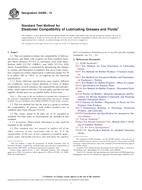Potrebujeme váš súhlas na využitie jednotlivých dát, aby sa vám okrem iného mohli ukazovať informácie týkajúce sa vašich záujmov. Súhlas udelíte kliknutím na tlačidlo „OK“.
ASTM D4289-13
Standard Test Method for Elastomer Compatibility of Lubricating Greases and Fluids
Automaticky preložený názov:
Štandardná skúšobná metóda pre Elastomér Kompatibilita mazacie tuky a kvapalín
NORMA vydaná dňa 1.12.2013
Informácie o norme:
Označenie normy: ASTM D4289-13
Poznámka: NEPLATNÁ
Dátum vydania normy: 1.12.2013
Kód tovaru: NS-26693
Počet strán: 8
Približná hmotnosť: 24 g (0.05 libier)
Krajina: Americká technická norma
Kategória: Technické normy ASTM
Anotácia textu normy ASTM D4289-13 :
Keywords:
compatibility, density, elastomer, fluid, grease, immersion, lubricant, lubricating grease, relative, rubber, seal(s), ICS Number Code 75.100 (Lubricants, industrial oils and related products)
Doplňujúce informácie
| Significance and Use | ||||||||||||||||||||||||||||||||
|
5.1 Measurement of the changes in the volume and hardness of an elastomer that occur from immersion in a lubricating grease or fluid provides a means for evaluating relative compatibility. Much of this test method was derived from procedures described in Test Method D471 and Federal Test Method 791C/3603.5. In contrast to these two test methods, which emphasize the evaluation of rubber and rubber-like compounds, Test Method D4289 was developed specifically to evaluate lubricating greases and fluids, especially those used in automotive applications, although the test method can be applied to lubricants used in industrial applications as well. Excepting the Shore Durometer A, this test method requires no specialized, rubber-testing equipment. Virtually all other equipment and supplies specified in the procedure are stock items in lubricants laboratories. 5.2 The volume and hardness-change values determined by this test method do not duplicate similar changes that occur in elastomeric seals under actual service conditions. However, they can be correlated in many instances. In one such instance, the volume-change values determined by the antecedent of this test method correlated (r 2 = 0.99) with those that occurred during a vehicle test.5.3 When the optional Reference Elastomers AMS 3217/2C (acrylonitrile-butadiene, NBR-L) and AMS 3217/3A (chloroprene, CR) are used to evaluate compatibility, the results can be used to judge a service characteristic of lubricants. In this respect, this test method is useful for lubricant specifications (for example, Specification D4950). Similarly, this test method can be used in specifications for lubricating fluids as well. 5.4 With specifications requiring elastomers other than Reference Elastomers AMS 3217/2C or AMS 3217/3A, coupons cut from standard sheets (Practice D3182) should be used. When the preparation of such coupons is not feasible, or the lubricant specification requires the use of rubber products that do not have a suitable size or configuration for use in preparing coupons for testing (Practice D3183), this test method can be used as a guide for evaluating compatibility. 5.5 The results of this test method
are most applicable to the use of lubricating greases and fluids in
contact with elastomeric seals, boots, O-rings, and similar
products, where the physical demands on the elastomer are not
extreme. In critical applications where the lubricant will be in
contact with rubber parts subject to severe flexing, extreme
temperatures, or similar stresses, other rubber properties, such as
tensile strength and elongation, should also be evaluated as they
may be more indicative of the true compatibility
characteristics.
|
||||||||||||||||||||||||||||||||
| 1. Scope | ||||||||||||||||||||||||||||||||
|
1.1 This test method evaluates the compatibility of lubricating greases and fluids with coupons cut from standard elastomer sheets (Practice D3182) or, optionally, from SAE Specification AMS 3217/2C (NBR-L) and AMS 3217/3A (CR) sheets. Compatibility is evaluated by determining the changes in volume and Durometer A hardness that occur when elastomer coupons are totally immersed in a lubricant sample for 70 h at either 100 or 150°C or as required by the lubricant specification. 1.1.1 Some lubricant specifications may require different test conditions, such as longer durations or lower or higher temperatures. In such instances, the repeatability and reproducibility values stated in Section 12 do not apply, and the user and supplier should agree on acceptable limits of precision. 1.2 This test method can also be
used as a guide to evaluate the compatibility of greases with
rubber products not in standard sheet form (Practice D3183).
1.3 The values stated in SI units are to be regarded as standard. No other units of measurement are included in this standard. 1.3.1 Exception—When listed, Durometer A units shall be regarded as the standard. 1.4 This standard does not
purport to address all of the safety concerns, if any, associated
with its use. It is the responsibility of the user of this standard
to establish appropriate safety and health practices and determine
the applicability of regulatory limitations prior to
use.
USAF-539 Specification Bulletin for Standard
Elastomer Stocks Federal Test Method Standard?791C, Method?3603.5, Swelling of Synthetic
Rubbers Standard Specification for Reagent
Water AMS 3217A Standard Elastomer Stocks--Test Slabs Standard Test Method for Rubber
Property—Effect of Liquids (Includes all amendments and changes
6/25/2021). ADJD6300 D2PP, Version 4.43,
Determination of Precision and Bias Data for Use in Test Methods
for Petroleum Products Available from ASTM International
Headquarters. Order Adjunct No. . Originally produced in 2006. AMS 3217/3B Test Slabs, Chloroprene (CR)--65-75 Standard Practice for Rubber´Preparation
of Pieces for Test Purposes from Products Standard Practice for Rubber—Materials,
Equipment, and Procedures for Mixing Standard Compounds and
Preparing Standard Vulcanized Sheets (Includes all amendments and
changes 11/12/2021). AMS 3217/2C Test Slabs, Acrylonitrile Butadiene
(NBR-L)--Low Acrylonitrile, 65-75 Standard Test Methods for Vulcanized
Rubber and Thermoplastic Elastomers—Tension Standard Test Methods for Rubber
Products—Chemical Analysis Standard Test Methods for Cone
Penetration of Lubricating Grease (Includes all amendments and
changes 12/20/2021). Standard Test Method for Rubber
Property—Durometer Hardness Standard Terminology Relating to
Petroleum Products, Liquid Fuels, and Lubricants (Includes all
amendments and changes 12/21/2023). Standard Classification and Specification
for Automotive Service Greases |




 Cookies
Cookies
